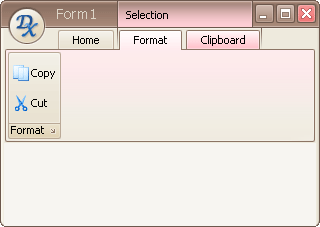RibbonControl.SelectedPage Property
Gets or sets the currently selected page.
Namespace: DevExpress.XtraBars.Ribbon
Assembly: DevExpress.XtraBars.v19.1.dll
Declaration
Property Value
| Type | Default | Description |
|---|---|---|
| RibbonPage | *null* | A RibbonPage object that represents the page currently selected. null (Nothing in Visual Basic) if the RibbonControl.Pages collection is empty. |
Remarks
If the current ribbon is merged with another ribbon as a child, use the RibbonControl.SelectPage method.
Example
The following example demonstrates how to create contextual tab pages in the RibbonControl in code.
In the example, a RibbonControl control is created containing one permanently displayed page (“Home”) and two contextual pages (“Format” and “Clipboard”). The contextual pages are combined into a custom page category (“Selection”).
Contextual pages are hidden when they are created. They are made visible later via the category’s RibbonPageCategory.Visible property.
The following image demonstrates code execution:

using DevExpress.XtraBars.Ribbon;
using DevExpress.XtraBars;
// Create a RibbonControl.
RibbonControl Ribbon = new RibbonControl();
// Assign a collection of images that will be used by bar items.
Ribbon.Images = imageCollection1;
// Create a page and associate it with the default category.
RibbonPage pageHome = new RibbonPage("Home");
Ribbon.Pages.Add(pageHome);
// Create a custom Selection page category.
RibbonPageCategory catSelection = new RibbonPageCategory("Selection", Color.LightPink, false);
Ribbon.PageCategories.Add(catSelection);
// Create two contextual pages (Format an Clipboard)in the Selection category.
RibbonPage contextPageFormat = new RibbonPage("Format");
RibbonPage contextPageClipboard = new RibbonPage("Clipboard");
catSelection.Pages.AddRange(new RibbonPage[] {contextPageFormat, contextPageClipboard});
// Customize the Format page by adding a Format group with two bar items to it.
RibbonPageGroup groupFormat = new RibbonPageGroup("Format");
groupFormat.AllowTextClipping = false;
// Add two items to the Format group
BarButtonItem itemCopy = new BarButtonItem(Ribbon.Manager, "Copy", 0);
BarButtonItem itemCut = new BarButtonItem(Ribbon.Manager, "Cut", 1);
groupFormat.ItemLinks.AddRange(new BarItem[] {itemCopy, itemCut});
contextPageFormat.Groups.Add(groupFormat);
// Subscribe to an event which fires when any item is clicked.
Ribbon.ItemClick += new ItemClickEventHandler(Ribbon_ItemClick);
// Add the RibbonControl to the form.
this.Controls.Add(Ribbon);
//...
// Make the Selection category visible
catSelection.Visible = true;
// Activate the category's first page.
Ribbon.SelectedPage = catSelection.Pages[0];
// Respond to item clicking.
void Ribbon_ItemClick(object sender, ItemClickEventArgs e) {
//...
}
Related GitHub Examples
The following code snippets (auto-collected from DevExpress Examples) contain references to the SelectedPage property.
Note
The algorithm used to collect these code examples remains a work in progress. Accordingly, the links and snippets below may produce inaccurate results. If you encounter an issue with code examples below, please use the feedback form on this page to report the issue.